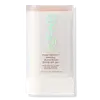What's inside
What's inside
 Key Ingredients
Key Ingredients

 Benefits
Benefits

 Concerns
Concerns

 Ingredients Side-by-side
Ingredients Side-by-side

Ethylhexyl Methoxycinnamate 3%
UV AbsorberTitanium Dioxide 22.85%
Cosmetic ColorantAluminum Hydroxide
EmollientButyloctyl Salicylate
Skin ConditioningC12-15 Alkyl Benzoate
AntimicrobialCaprylyl Methicone
Skin ConditioningCI 77491
Cosmetic ColorantCI 77492
Cosmetic ColorantCI 77499
Cosmetic ColorantCopernicia Cerifera Wax
Dimethicone
EmollientEthylhexylglycerin
Skin ConditioningHydrogenated Polydecene
EmollientIsononyl Isononanoate
EmollientIsopropyl Myristate
EmollientIsopropyl Titanium Triisostearate
EmollientIsostearic Acid
CleansingKaolin
AbrasiveMethyl Methacrylate Crosspolymer
Microcrystalline Wax
Emulsion StabilisingPhenoxyethanol
PreservativePhytosteryl/Behenyl/Octyldodecyl Lauroyl Glutamate
Skin ConditioningPolyethylene
AbrasivePolyhydroxystearic Acid
EmulsifyingPropylene Carbonate
SolventStearalkonium Hectorite
Gel FormingTocopherol
AntioxidantEthylhexyl Methoxycinnamate 3%, Titanium Dioxide 22.85%, Aluminum Hydroxide, Butyloctyl Salicylate, C12-15 Alkyl Benzoate, Caprylyl Methicone, CI 77491, CI 77492, CI 77499, Copernicia Cerifera Wax, Dimethicone, Ethylhexylglycerin, Hydrogenated Polydecene, Isononyl Isononanoate, Isopropyl Myristate, Isopropyl Titanium Triisostearate, Isostearic Acid, Kaolin, Methyl Methacrylate Crosspolymer, Microcrystalline Wax, Phenoxyethanol, Phytosteryl/Behenyl/Octyldodecyl Lauroyl Glutamate, Polyethylene, Polyhydroxystearic Acid, Propylene Carbonate, Stearalkonium Hectorite, Tocopherol
Zinc Oxide 23.8%
Cosmetic ColorantHelianthus Annuus Seed Cera
EmollientCaprylic/Capric Triglyceride
MaskingDicaprylyl Carbonate
EmollientCoco-Caprylate
EmollientC12-15 Alkyl Benzoate
AntimicrobialEthyl Macadamiate
Skin ConditioningDipentaerythrityl Hexahydroxystearate/Hexastearate/Hexarosinate
Skin ConditioningOctyldodecanol
EmollientArgania Spinosa Kernel Oil
EmollientButyrospermum Parkii Butter
Skin ConditioningTocopheryl Acetate
AntioxidantCopernicia Cerifera Wax
Methyl Dihydroabietate
Helianthus Annuus Seed Oil
EmollientEuphorbia Cerifera Wax
Tocopherol
AntioxidantJojoba Esters
EmollientBehenyl Behenate
EmollientPolyhydroxystearic Acid
EmulsifyingC18-38 Alkyl Hydroxystearoyl Stearate
EmollientSorbitan Sesquioleate
EmulsifyingIsostearic Acid
CleansingLecithin
EmollientPolyglyceryl-3 Polyricinoleate
EmulsifyingBisabolol
MaskingMalic Acid
BufferingCitric Acid
BufferingCanola Oil
EmollientCI 77491
Cosmetic ColorantCI 77492
Cosmetic ColorantFarnesol
PerfumingZinc Oxide 23.8%, Helianthus Annuus Seed Cera, Caprylic/Capric Triglyceride, Dicaprylyl Carbonate, Coco-Caprylate, C12-15 Alkyl Benzoate, Ethyl Macadamiate, Dipentaerythrityl Hexahydroxystearate/Hexastearate/Hexarosinate, Octyldodecanol, Argania Spinosa Kernel Oil, Butyrospermum Parkii Butter, Tocopheryl Acetate, Copernicia Cerifera Wax, Methyl Dihydroabietate, Helianthus Annuus Seed Oil, Euphorbia Cerifera Wax, Tocopherol, Jojoba Esters, Behenyl Behenate, Polyhydroxystearic Acid, C18-38 Alkyl Hydroxystearoyl Stearate, Sorbitan Sesquioleate, Isostearic Acid, Lecithin, Polyglyceryl-3 Polyricinoleate, Bisabolol, Malic Acid, Citric Acid, Canola Oil, CI 77491, CI 77492, Farnesol
Ingredients Explained
These ingredients are found in both products.
Ingredients higher up in an ingredient list are typically present in a larger amount.
C12-15 Alkyl Benzoate is made up of Benzoic Acid and long chain alcohols. It has a low molecular weight.
C12-15 Alkyl Benzoate is an emollient and texture enhancer. Due to its solubility, it is often used in sunscreens to help evenly distribute active ingredients.
As an emollient, C12-15 Alkyl Benzoate helps soften and hydrate your skin. Emollients create a film on your skin that traps moisture within.
This ingredient has been reported to cause eye irritation.
Learn more about C12-15 Alkyl BenzoateCi 77491 is also hydrated iron III oxide. It's sole purpose is to give a red/pink hue to products.
Iron III oxides are classified as inorganic chemicals for coloring.
Synthetically created Ci 77491 is considered safer than those naturally found. This is because the synthetically created version may contain less impurities. Iron oxides are generally non-toxic and non-allergenic.
Learn more about CI 77491Ci 77492 is also hydrated iron III oxide. It's sole purpose is to give a yellow hue to products.
Iron III oxides are classified as inorganic chemicals for coloring.
Synthetically created Ci 77492 is considered safer than those naturally found. This is because the synthetically created version may contain less impurities. Iron oxides are generally non-toxic and non-allergenic.
Learn more about CI 77492Copernicia Cerifera Wax comes from a palm tree native to Brazil; another name for this ingredient is Carnauba Wax.
This ingredient is used to thicken texture and also leaves behind a film when applied.
Fun fact: This wax has the highest melting point of all natural waxes and low solubility.
Learn more about Copernicia Cerifera WaxIsostearic acid is a saturated fatty acid. Its structure makes it a great surfactant.
Surfactants help decrease the surface tension between two liquids. This property also makes it an effective emulsifier. Emulsifiers help prevent waters and oils from separating in a product.
Isostearic Acid is created from oleic acid.
This ingredient may not be Malassezia folliculitis, or fungal-acne safe.
Learn more about Isostearic AcidPolyhydroxystearic Acid is a soft wax made from castor oil.
It is is a texture thickener, emulsifier, and film-former. Emulsifiers prevent ingredients from separating, such as oils and waters.
Polyhydroxystearic Acid may not be fungal acne safe.
Learn more about Polyhydroxystearic AcidTocopherol (also known as Vitamin E) is a common antioxidant used to help protect the skin from free-radicals and strengthen the skin barrier. It's also fat soluble - this means our skin is great at absorbing it.
Vitamin E also helps keep your natural skin lipids healthy. Your lipid skin barrier naturally consists of lipids, ceramides, and fatty acids. Vitamin E offers extra protection for your skin’s lipid barrier, keeping your skin healthy and nourished.
Another benefit is a bit of UV protection. Vitamin E helps reduce the damage caused by UVB rays. (It should not replace your sunscreen). Combining it with Vitamin C can decrease sunburned cells and hyperpigmentation after UV exposure.
You might have noticed Vitamin E + C often paired together. This is because it is great at stabilizing Vitamin C. Using the two together helps increase the effectiveness of both ingredients.
There are often claims that Vitamin E can reduce/prevent scarring, but these claims haven't been confirmed by scientific research.
Learn more about Tocopherol